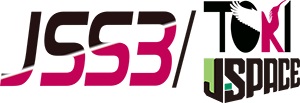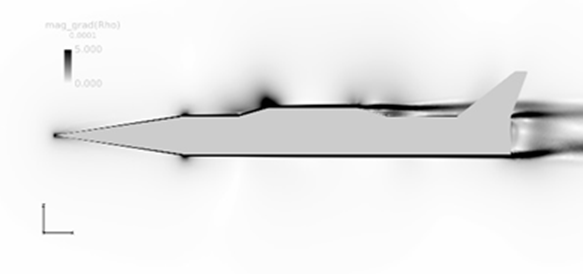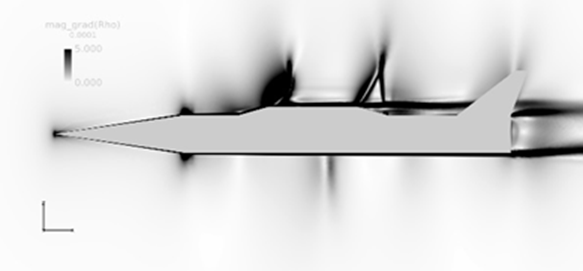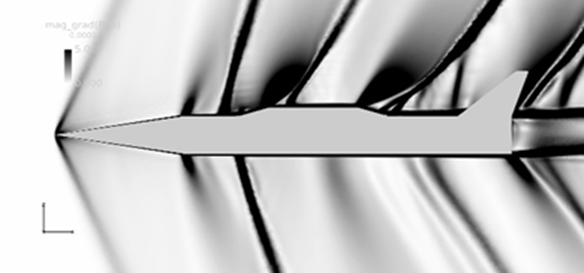Research on the Future Transportation Technology ( Integrated Design of Airframe and Engine)
JAXA Supercomputer System Annual Report April 2017-March 2018
Report Number: R17EG3103
Subject Category: Research and Development
- Responsible Representative: Kouichi Okita Research and Development Directorate, Unit IV
- Contact Information: Susumu Hasegawa hasegawa.susumu@jaxa.jp
- Members: Susumu Hasegawa
Abstract
The establishment of technologies for airframe/engine integration of the spaceplane for the realization of future space transportation technology.
Reference URL
N/A
Reasons for using JSS2
The comparison between the experimental data obtained by wind tunnel tests and the numerical results were conducted and verified. After the verifications of numerical results, various aerodynamic data which are difficult to obtain by experiments are computed and analyzed by CFD for the realization of the spaceplane.
Achievements of the Year
Correspondent numerical calculations of spaceplane performed by wind tunnel experiment were carried out. Comparing the experimental results with the numerical calculation results, computational results obtained by CFD are in good agreement with experimental results. Furthermore, in order to improve the spaceplane configuration, the configuration where flow separation was likely to occur was identified in each flight Mach number. We changed the spaceplane configuration of the second phase spaceplane and conducted the wind tunnel tests in December, 2017. Moreover, the analysis of ejector experiments was carried out using CFD.
Publications
■ Peer-reviewed papers
1)Susumu Hasegawa, Takeshi Kanda: “Preliminary Numerical Simulation of Flow around Spaceplane for Airframe Engine Integration”, Transactions of JSASS, Aerospace Technology Japan.
■ Non peer-reviewed papers
1)Kanenori Kato, Kouichi Takasaki, Kouichiro Tani, Susumu Hasegawa, Kazuhide Mizobata, and Takeshi Kanda, “Coupled Aerodynamic Characteristics of Airframe and Engine of Space Plane”, 31st ISTS, 2017-a-41, Matsuyama, Ehime, Japan. Jun. 2017.
2)Susumu Hasegawa, Kanda Takeshi : Numerical analysis of the flowfield around the spaceplane tested in the transonic wind tunnel, JSASS Northern Branch 2018 Annual Meeting, Sendai, May. 2018.
■ Presentations
1)Susumu Hasegawa, Takeshi Kanda: “Preliminary Numerical Simulation of Flow around Spaceplane for Airframe Engine Integration “, 31st ISTS, 2017-a-40, Matsuyama, Ehime, Japan. Jun. 2017.
2)Kanenori Kato, , Kouichi Takasaki, Kouichiro Tani, Susumu Hasegawa, Kazuhide Mizobata, and Takeshi Kanda, “Coupled Aerodynamic Characteristics of Airframe and Engine of Space Plane”, 31st ISTS, 2017-a-41, Matsuyama, Ehime, Japan. Jun. 2017.
3)Susumu Hasegawa, Kanda Takeshi : Numerical analysis of the flowfield around the spaceplane tested in the transonic wind tunnel, JSASS Northern Branch 2018 Annual Meeting, Sendai, May. 2018.
Usage of JSS2
Computational Information
- Process Parallelization Methods: MPI
- Thread Parallelization Methods: OpenMP
- Number of Processes: 32 – 256
- Elapsed Time per Case: 3.00 hours
Resources Used
Fraction of Usage in Total Resources*1(%): 0.04
Details
Please refer to System Configuration of JSS2 for the system configuration and major specifications of JSS2.
| System Name | Amount of Core Time(core x hours) | Fraction of Usage*2(%) |
|---|---|---|
| SORA-MA | 279,219.58 | 0.04 |
| SORA-PP | 105.87 | 0.00 |
| SORA-LM | 0.00 | 0.00 |
| SORA-TPP | 0.00 | 0.00 |
| File System Name | Storage Assigned(GiB) | Fraction of Usage*2(%) |
|---|---|---|
| /home | 004.45 | 0.00 |
| /data | 4,231.77 | 0.08 |
| /ltmp | 651.04 | 0.05 |
| Archiver Name | Storage Used(TiB) | Fraction of Usage*2(%) |
|---|---|---|
| J-SPACE | 0.57 | 0.02 |
*1: Fraction of Usage in Total Resources: Weighted average of three resource types (Computing, File System, and Archiver).
*2: Fraction of Usage:Percentage of usage relative to each resource used in one year.
JAXA Supercomputer System Annual Report April 2017-March 2018






